Let ABC be an isosceles triangle (AB = AC) with angle BAC = 20°.
Point D is on side AC such that angle DBC = 60°.
Point E is on side AB such that angle ECB = 50°.
Find the measure of angle EDB.
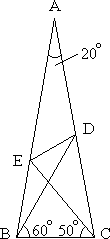
Solution to the Problem:
Angle EDB = 30°.This geometry problem dates back to at least 1922, when it appeared in the Mathematical Gazette, Volume 11, p. 173. It appears to be an easy problem, but it is deceivingly difficult.
I tried to solve the problem using the following facts:
- If two sides of an isosceles triangle are congruent,
Then the angles opposite those sides are congruent. - The sum of the measures of the three angles of a triangle is 180°.
- The sum of the measures of the angles which form a line is 180°.
- The sum of the measures of the four angles of a quadrilateral is 360°.
I was left with four angles that I couldn't find.
I let x = angle BDE, y = angle DEC, w = angle AED, and z = angle ADE.
Then I wrote several equations and tried to solve them simultaneously:
x + y = 110°
w + y = 130°
x + z = 140°
w + z = 160°
x + y + w + z = 270°, etc.
But I had difficulty finding the unique values for x, y, w, and z;
and yet, I knew
that there was only one solution.
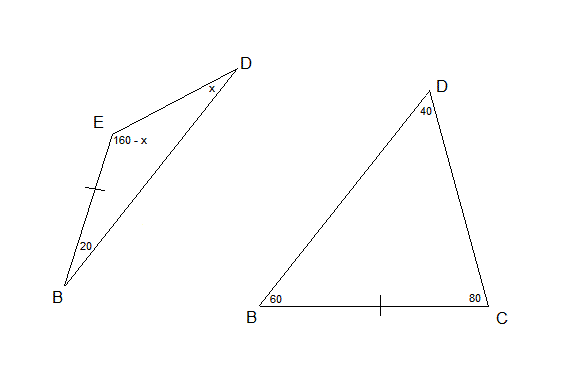
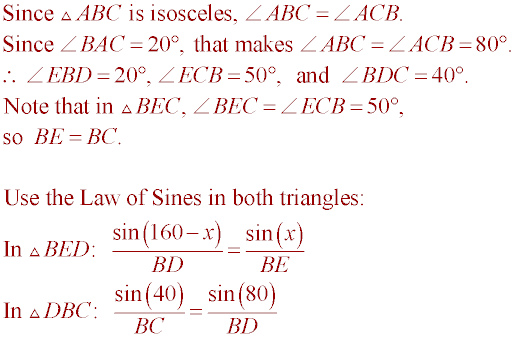
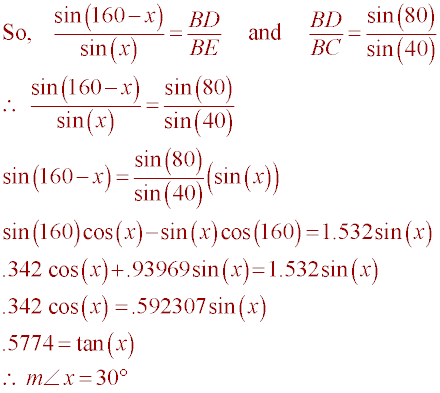
Here is the complete solution of the triangle:
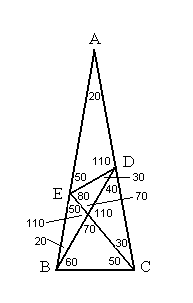
Tom Robb sent in a completely different solution to the problem: In ABC, let BC=1 <B = < C = 20 in Triangle BEC, <BEC = 50 therefore, BE = BC =1 Draw Altitude AK, and AB = 0.5/cos(80) m<ADP=70 With Triangle ADB being isosceles, draw altitude DP and BP=1/2(AB) ~1.4396926 PE= BP - BE = 0.4396926 PD = BP*tan(20) ~ 0.52400526 Now <PDE = inverse tangent (PE/PD) = 40 So 70 + 40 + m<EDB + 40 = 180 and finally, m<EDB = 30 degrees
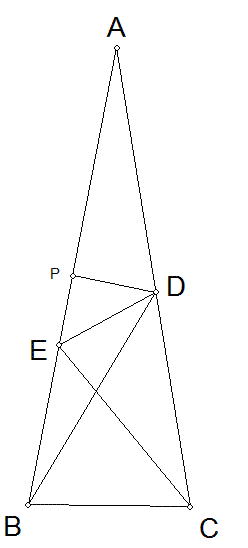
Tristan Collins sent in still a different solution using trig as did Walt Arrison. Those were the only proofs that were sent, but one of the teachers at my school said he did it with just geometry. Many others drew scale drawings to solve the problem. Below is Walt Arrison's proof: 1) Call the intersection of BD & CE = F 2) Assume the length of AB as 200' (or any distance that you want). 3) Since FBC = 60°, and FCB = 50°, BFC & EFD = 70°. (Note: by subtraction ABD = 20° and ACE = 30°) 4) BFE & CDE = 110°, FBE = 50°, & FDC = 40°. 5) Sin A/2 x 200 = 34.73. 6) BC = 69.46. 7)Sin 70° : 69.46 = Sin 60° : CF = Sin 50° : BF. BF = 56.62, CF = 64.015. 8) Sin 110° : BE = Sin 20° : EF = Sin 50° : BF. EF = 25.28, BE = 69.46 (Hmmm - another isosceles triangle!) 9) Sin 110° : CD = Sin 30° : DF = Sin 40° : CF. CD = 93.583, DF = 49.795. 10) DE2 = EF2 + DF2 - 2 x EF x DF x cos EFD 11) DE2 = 25.282 + 49.7952 - (2 x 25.28 x 49.795) x cos 70° 12) DE = 47.513 13) Sin 70° : 47.513 = Sin EDF : 25.28. 14) EDF = 30°.
Correctly solved by:
| 1. Walt Arrison | Philadelphia, Pennsylvania |
| 2. Mike Singer | Winchester, Virginia |
| 3. Cameron S. | Columbus, Georgia |
| 4. David & Judy Dixon | Bennettsville, South Carolina |
| 5. Tom Robb | Winchester, Virginia |
| 6. Wajih Ansari | Harrisonburg, Virginia |
| 7. Mac Dillon | Columbus, Georgia |
| 8. Jeffrey Gaither | Winchester, Virginia |
| 9. Arsalan Heydarian | Harrisonburg, Virginia |
| 10. Tristan Collins | Winchester, Virginia |
| 11. Daniel Gardiner | Winchester, Virginia |
| 12. Hamza Rashid | Harrisonburg, Virginia |
| 13. Rob Adams | Winchester, Virginia |
| 14. Daniel Surber | Winchester, Virginia |
| 15. James Alarie | University of Michigan -- Flint, Flint, Michigan |
| 16. Okechi Egekwu | Harrisonburg, Virginia |